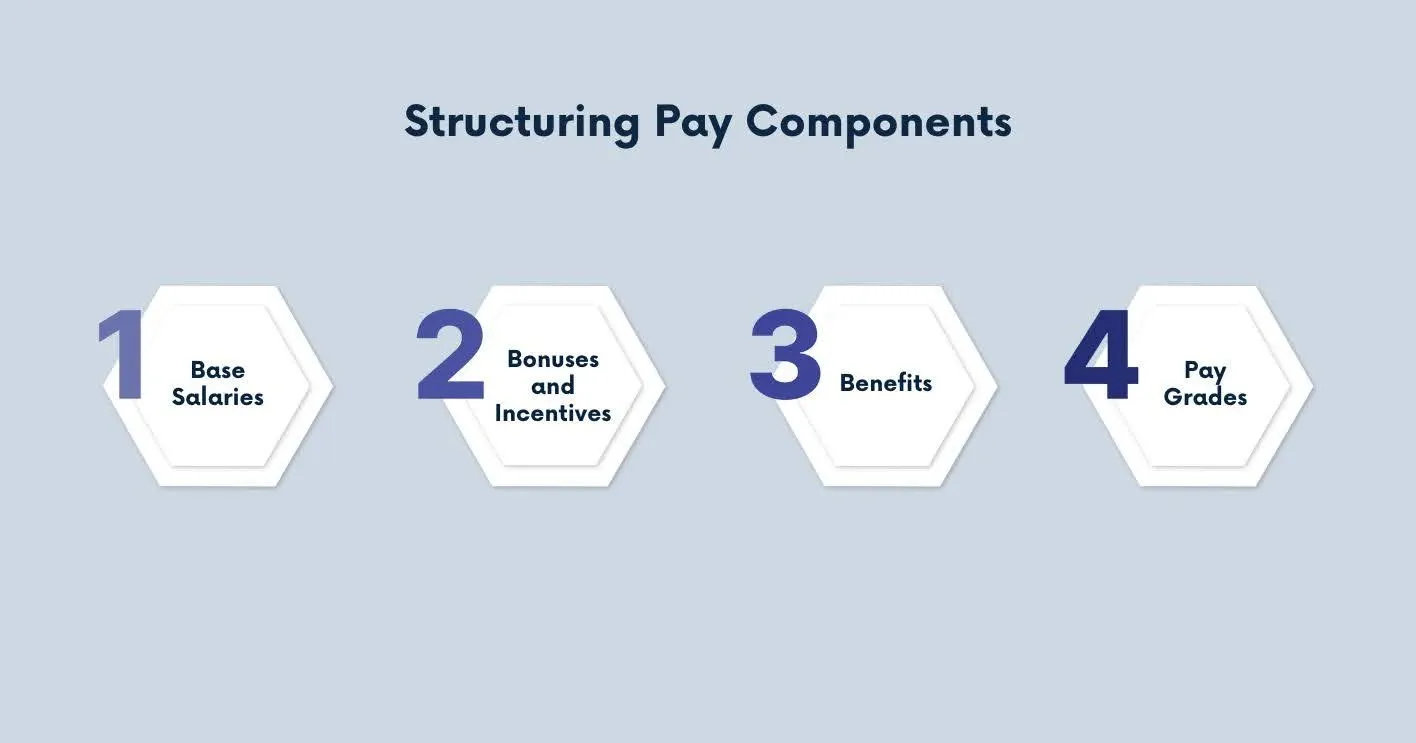
When you’re working in Human Resources (HR), competitive pay is not just a buzzword. It is the foundation of hiring and retaining top talent. A well-structured compensation policy helps you deal with challenges faced by HR professionals in balancing the organization's budget with the need to offer competitive salaries and benefits.
However, the bigger question is what a competitive pay structure is, and how do you know it is competitive? After all, as an HR professional, you need to know if what you’re offering is actually as per industry standards or if you need to make some adjustments without straining the company’s resources.
In this blog, we will walk you through the basics of developing a competitive pay structure, ensuring that your compensation practices are aligned with market standards while also fostering fairness and transparency within your organization.
A competitive pay structure is essential for any business aiming to thrive in the modern workforce. The first step in defining this structure is understanding the need to align your salaries with industry standards. When wages are competitive, you're more likely to attract qualified nominees and keep your current employees satisfied and motivated. The right pay structure is a direct reflection of how your company values its workforce, and it plays a significant role in your talent acquisition and retention strategies.
Fair compensation is more than just about keeping up with competitors; it’s about ensuring your employees feel their work is valued. A competitive pay structure helps your organization stay competitive in the talent market, which is increasingly important as companies adapt to the challenges of a changing economy.
In order to define a competitive pay structure for your company, you need to have a clear pay philosophy. But what does it mean? Let’s find out.
Suggested Read: Understanding What Salary Bands and Pay Bands Mean
Once you’ve recognized the importance of a competitive pay structure, the next step is deciding on your pay philosophy. Pay philosophy refers to how your company positions itself in relation to the market when it comes to compensation. Do you want to match, lead, or lag behind the market?
Aligning pay with industry averages ensures competitiveness without going beyond what’s necessary. This approach helps attract and retain talent, especially in stable or moderately competitive industries, without exceeding financial limits. It’s about staying on par with competitors without overextending.
Leading the market means offering above-average salaries to attract top talent, especially when competition for skilled employees is high. This approach is ideal for companies in fast-growing sectors or those requiring niche skills. While it helps secure the best candidates, it requires a solid budget to sustain higher salary offerings.
Lagging the market involves offering salaries below the industry average, but with compensation in other areas, like flexible work hours, career growth, or a strong company culture. This can appeal to employees who value work-life balance or long-term benefits over immediate financial compensation. It’s a strategic choice for companies focused on sustainability rather than short-term gains.
Your pay philosophy is shaped by your company’s goals and financial situation. Fast-growing companies or those in competitive industries might need to lead the market, while businesses with limited budgets may opt to match the market. Some may choose to lag, compensating with benefits like career development or culture.
Finding the right balance ensures your pay strategy aligns with your broader objectives. While attractive salaries help you attract top candidates, ensuring fair pay for existing employees is crucial to keeping them happy and motivated.
Let’s see how market data research can help you prepare a truly competitive pay structure.
Suggested Read: Pay Transparency: Understanding Salaries in the Workplace
A competitive pay structure isn’t developed in a vacuum. It requires diligent research to compare compensation packages with those of competitors in the industry. By using reliable sources like industry-specific surveys, HR professionals can ensure that their salary ranges are in line with market trends.
Additionally, compensation is not one-size-fits-all. It’s important to factor in broader labor market conditions and regional variations when determining salary packages. For instance, salaries in high-cost living areas like New York City or San Francisco are typically higher due to the elevated cost of living in these regions. On the other hand, salaries in more affordable areas, such as the Midwest, may be lower. These regional differences can have a considerable impact on how employees perceive their compensation, so it’s critical to consider geographic location when developing a pay structure.
Taking local market conditions into account ensures that your compensation remains competitive within the relevant job market. By acknowledging cost-of-living variations and adjusting salaries accordingly, you can attract and retain talent across different regions, all while ensuring fairness and equity for employees in diverse locations. This approach allows HR professionals to offer competitive salaries while maintaining internal consistency, ultimately building a compensation structure that is both fair and effective.
Once you’ve defined your pay philosophy and researched the market, it’s time to structure the pay components.
Suggested Read: Creating a Compensation Job Offer Letter: A Template Guide for Every Situation

A competitive pay structure typically includes base salaries, bonuses, and benefits. The mix of these components will depend on your company’s compensation strategy.
Base salaries are the foundation of any pay structure and should reflect the skills, experience, and responsibilities of each role. These salaries should be competitive and aligned with market standards, considering factors like job complexity and required expertise. For instance, senior roles or specialized positions typically warrant higher base pay. A well-set base salary not only attracts the right talent but also establishes a fair and sustainable compensation foundation.
Bonuses and incentives are performance-based rewards that motivate employees to meet specific goals. These can include annual bonuses, project-based incentives, or sales commissions tied to measurable outcomes. Incentives encourage employees to go above and beyond, aligning their efforts with company objectives. Offering these rewards enhances motivation, fosters a results-driven culture, and recognizes high performers for their contributions.
A strong benefits package is crucial for rounding out a competitive pay structure. Health insurance, retirement plans, paid time off (PTO), and other perks add significant value to compensation. Benefits help attract and retain talent by supporting employees' well-being and providing long-term security. Additional perks like wellness programs, flexible work arrangements, and professional development opportunities further enhance your pay structure, making your company more appealing to potential hires.
Creating pay grades and ranges for different job roles is also essential. Pay grades help organize salaries based on job responsibilities and experience levels, while pay ranges provide flexibility within each grade. Additionally, ensuring pay equity across all levels of your organization is crucial for maintaining fairness and compliance with legal standards, particularly regarding gender and race.
The next step after creating a pay structure is to implement it. This can pose challenges of its own. Let’s take a closer look.
Implementing the pay structure involves organizing jobs into groups with corresponding pay ranges and making sure employees understand how their roles fit into the structure.
Clear communication is critical. HR professionals should ensure that the pay structure is communicated transparently within the organization so that employees understand how their pay is determined and what they can do to progress. This transparency fosters trust and reduces the risk of dissatisfaction regarding compensation.
Another important step is to train managers. They must be equipped to discuss compensation with employees, particularly when it comes to explaining pay increases, bonuses, or adjustments based on market changes. This is especially helpful during the appraisal process, as the managers have to explain these components to the employees.
Next up is monitoring the effectiveness of the pay structure. This will help you comprehend what’s working and what needs to be reworked.
Suggested Read: Exploring Different Types and Methods of Performance Appraisal
A competitive pay structure is not static. Market conditions, economic shifts, and company goals evolve, and so should your pay structure. Regularly reviewing and updating salary ranges will help ensure that your compensation packages remain competitive over time.
Feedback from employees is a valuable tool in assessing the effectiveness of your pay structure. Conducting surveys or informal check-ins can help you understand employee satisfaction and identify areas where improvements may be needed.
Finally, adapting to economic shifts is essential. As inflation rises or new industry standards emerge, you may need to adjust your pay structure to stay competitive. Constantly assessing and tweaking your pay structure will help you retain top talent and remain a preferred employer in your industry.
To wrap it up, building a competitive pay structure is more than just setting salary figures; it's about creating a compensation plan that attracts and keeps the best talent while ensuring fairness within your organization. By understanding the market, defining your pay philosophy, and structuring salaries and benefits thoughtfully, you can create a system that not only aligns with industry standards but also supports your company’s long-term goals.
Remember, the work doesn’t stop once the pay structure is in place. Regularly reviewing and adapting to market changes, listening to employee feedback, and keeping open lines of communication will help you stay competitive and maintain trust within your workforce. A well-executed pay structure is a powerful tool that contributes to overall employee satisfaction and helps your organization thrive.
If you're looking to refine your compensation strategies and streamline your HR processes, CompUp is here to assist. Our expert solutions help optimize pay structures, ensure compliance, and improve overall HR efficiency.
Schedule a demo today to see how CompUp can transform your compensation planning and make your HR operations more effective and scalable.
1. What is a competitive pay structure?
A competitive pay structure is a compensation system that aligns salaries and benefits with industry standards to attract and retain top talent while ensuring fairness and budget balance.
2. How do I determine my company's pay philosophy?
Your pay philosophy defines how your company positions itself in relation to the market, whether you aim to match, lead, or lag behind industry standards. This decision is based on your business goals, financial situation, and the talent you're trying to attract.
3. How do I research market data to build a competitive pay structure?
Use reliable sources like industry-specific surveys and pay data to compare your compensation packages with competitors. Consider regional variations, such as cost-of-living differences, to ensure fairness and competitiveness in various locations.
4. What are the main components of a competitive pay structure?
A competitive pay structure typically includes base salaries, bonuses and incentives, and benefits. These components should be aligned with market standards and tailored to your company's compensation strategy and goals.
5. How do I implement and adapt my pay structure over time?
Clearly communicate the pay structure to employees and ensure managers are trained to discuss compensation. Regularly review and update the structure based on market shifts, employee feedback, and economic conditions to maintain competitiveness and satisfaction.

Revolutionizing Pay Strategies: Don't Miss Our Latest Blogs on Compensation Benchmarking